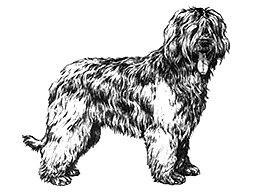Briard
Last updated: 03 Aug 2008
A breed standard is the guideline which describes the ideal characteristics, temperament, and appearance of a breed and ensures that the breed is fit for function with soundness essential. Breeders and judges should at all times be mindful of features which could be detrimental in any way to the health, welfare or soundness of this breed.

Kennel Club, London 1994
-
Group:
Group 5 (Working Dogs)
-
History:
-
General Appearance:
Rugged appearance; supple, muscular and well proportioned.
-
Characteristics:
Very intelligent, gay and lively.
-
Temperament:
Fearless, with no trace of timidity or aggressiveness.
-
Head And Skull:
Skull slightly rounded and slightly longer from occiput to stop than it is wide, when measured through points of cheekbones. Head is composed of two equal rectangles, occiput to stop and stop to end of nose, when viewed in profile from above. Muzzle square and very strong; any tendency to snipiness highly undesirable. Stop clearly defined. Nose large and square, always black.
-
Eyes:
Horizontally placed, well open and rather large, not oblique. Intelligent and gentle in expression. Dark brown, eye rims always black.
-
Ears:
Set on high and covered with long hair. Should not lie too flat against side of head. Fairly short, length of ear being equal to or slightly less than half length of head. When dog alert, ears should be lifted slightly and swing very slightly forward.
-
Mouth:
Teeth very strong and white with a perfect, regular and complete scissor bite, i.e. upper teeth closely overlapping lower teeth and set square to the jaws. Lips always black.
-
Neck:
Of good length; strong and muscular; arched, giving proud carriage of head and flowing smoothly into well placed shoulders.
-
Forequarters:
Shoulders well angulated and well laid back, forelegs well muscled, strongly boned.
-
Body:
Back firm and level, chest broad, medium spring of rib, well let down, very slight slope at croup, determining set of tail. Very slightly longer in body than height at shoulder.
-
Hindquarters:
Well angulated, with hocks set not too low and turning neither in nor out, but leg below hock not quite vertical. Hindlegs, particularly thighs, well muscled. Double dewclaws, set low on hindlegs, of utmost importance.
-
Feet:
Strong, turning neither in nor out, slightly rounded, about mid-way between cat foot and hare foot. Nails always black, pads firm and hard, toes close together. Well covered with hair.
-
Tail:
Long, well covered with hair with upward hook at tip. Carried low but always held centrally. Bone of tail reaching at least point of hock.
-
Gait/Movement:
Effortless, and when dog extends himself covering a great deal of ground. Extremely supple, enabling dog to turn quickly. Strong, firm, very smooth with plenty of drive.
-
Coat:
Long (not less than 7 cms (2 1/2ins)) on body. Slightly wavy and very dry. A fine dense undercoat required all over body. Head carries hair forming a moustache, beard and eyebrows, lightly veiling eyes.
-
Colour:
All black, or with white hairs scattered through black coat. Fawn in all its shades, darker shades preferred. Fawns may have dark shadings on ears, muzzle, back and tail, but these shadings must blend gradually into rest of coat since any demarcation line denotes a bi-colour which is not permissible. May also be slate grey.
-
Sizes:
Height:
Dogs 61 - 69 cms (24 - 27 ins) at withers
Bitches 58 - 65 cms (22.75 - 25.5 ins) at withers
Slight undersize before 18 months, or slight oversize in maturity permissible.
-
Faults:
Any departure from the foregoing points should be considered a fault and the seriousness with which the fault should be regarded should be in exact proportion to its degree and its effect upon the health and welfare of the dog.
-
Notes:
Male animals should have two apparently normal testicles fully descended into the scrotum.
 For owners
For owners
 Members
Members
 Dogs Australia is a not-for-profit organisation advocating for the preservation of purebred dogs through ethical breeding.
It champions the highest standard of animal welfare through education and fostering dog-loving communities.
Internationally recognised and established in 1958 as the Australian National Kennel Council (ANKC),
the organisation promotes responsible dog ownership; maintains the ORCHID* heritable canine diseases database;
funds research into canine diseases; and supports state and territory-based member bodies.
Dogs Australia promotes breed conformation shows and community sports for dogs that fulfil a breed’s natural instincts.
Dogs Australia is a not-for-profit organisation advocating for the preservation of purebred dogs through ethical breeding.
It champions the highest standard of animal welfare through education and fostering dog-loving communities.
Internationally recognised and established in 1958 as the Australian National Kennel Council (ANKC),
the organisation promotes responsible dog ownership; maintains the ORCHID* heritable canine diseases database;
funds research into canine diseases; and supports state and territory-based member bodies.
Dogs Australia promotes breed conformation shows and community sports for dogs that fulfil a breed’s natural instincts.







